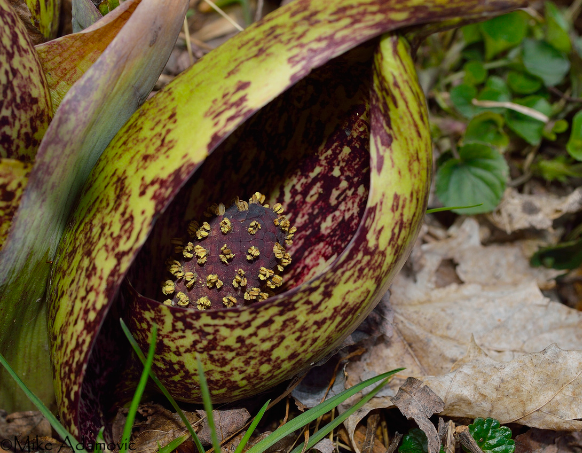Spring Flora and Fauna in the Adirondacks
Spring in the Adirondacks is a beautiful time of year. The woods and waters wake up from their winter slumber. The buds of trees and flowers start popping through the greyscale forest to add vibrant colors to the landscape. Little by little more signs of life reveal their resilience. There are two springtime plants that we love to look out for, Skunk Cabbage and Trout Lilies.
One of the most incredible plants to break ground in the late winter/early spring is Skunk Cabbage (Symplocarpus foetidus). This is because Skunk Cabbage can create its own heat to break through frozen ground and melt snow around it. This ensures its reproduction by securing first of the spring light. The amazing plant sends up a beautiful, variegated, purple spathe. The spathe is a firm, protective layer to the sexual organs of the plant, called the spadix. Go for a walk around the woods today and let your nose guide you.
Photo of Skunk Cabbage by Mike Adamovic
Trout Lilies (Erythronium americanum) are one of our favorite exhibits of the forest, opening its eyes to the new year of growth. Usually flowers are the star of the plant, but on the Trout Lily, there is no flower for the first four to seven years of growth. The identifiable mark is the brown and green spotted leaves. In time, the beautiful yellow flowers can cover the entire forest floor and leave you feeling like you are swimming with the native brook trout that their leaves so closely resemble.
Photo of Trout Lilies by Mike Adamovic
As a bonus, let’s talk about Brook Trout (Salvelinus fontinalis). The Brook Trout is the state fish of New York and the only native species of trout to Adirondack waterways. These fish are known for their wonderful patterns. Their population has struggled because they are incredibly sensitive to changes in water quality plus they are in competition with non-native species. The state is doing its best to help the species out by lowering acidity in waterways, asking anglers not to use non-native fish as bait, and stocking ponds with hatchery-raised Brook Trout. It’s a joy to see one in the wild. Hopefully they stay stunning for decades to come.
Photo of Brook Trout by John White
It is our duty as visitors and recreationalists to be conscious of these sensitive ecosystems and help support them in all the ways we can. This means not picking/moving/destroying these vital parts of our local habitat and being mindful that introduction of foreign species can jeopardize the health of these ecosystems. Stepping on plants, animals and fungi can kill them so be observant and stay on trail whenever possible.
Keep a lookout for these New York State natives. Contact us at PickleKnollOutdoors@gmail.com to meet more of our local flora and fauna.
Thanks for reading,
Aaron and Lily
Image Links
Mike Adamovic at https://adamovicnaturephotography.zenfolio.com/
John White at https://calphotos.berkeley.edu/cgi/img_query?enlarge=0000+0000+0704+0630
Information Links


